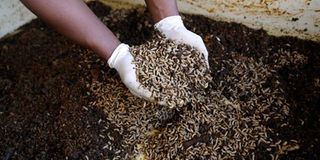Add value to those worms, maggots

Maggots and earthworms. Photo by Edgar Batte
What you need to know:
- Cultivation of earthworms and maggots known as vermiculture is taking shape in Uganda. Adding value to the worms by turning them into chicken and cattle feeds is the latest phenomenon, Desire Mbabaali writes.
High cost of feeds is among the challenges farmers face today. When it comes to poultry farming, the prices of poultry feeds keep fluctuating causing poultry farmers uncertainty and obviously, higher costs of production. However, being able to make your own feeds is both saving and innovative.
Christopher Bakawa, a student at Ndejje University pursuing a Bachelors of Agricultural Entrepreneurship and Farm Management shares how to make lasting, nutritious feeds from maggots.
“This is one of the ventures at our university meant to solve the problem our farmers face concerning feeding of their animals and birds,” he explains.
He further explains that maggots contain a lot of proteins. “There is also a tendency of duplication of feeds. For example, part of the silver fish powder can be sand and part of it is silver fish, bringing complications to birds such as failure to lay eggs. Again, after realising the problem with silver fish – being expensive and rare of late, we compared it to maggots,” he elaborates.
Apart from being free, maggots can be found or bred everywhere and anywhere making it easy for farmers since it can even be home made.
How to get maggots
“You can eat food, have leftovers and in a few days, you will have maggots. From the dregs of local brew, remains of animals from butcheries, the abattoir or decomposing matter. Since some farmers are Muslims and might be uncomfortable working with local brew extracts, they can use any other matter that decomposes to bring maggots. This then acts as the place where our maggots will feed and breed,” Bakawa notes.
For a sustainable supply, maggots are left to grow into black soldier flies. “In the larva stage, they are maggots, however when they grow, they become flies. So get your extract, put them in container or any surface (it works best in a netted area where flies cant escape). After a few days, these adults will lay eggs which in three to four days grow into maggots – which are our target in this case,” he narrates.
Heating the maggots
“I use a simple technology, one that is sustainable and easy to use,” Bakawa shares.
After the eggs mature into maggots, get an iron sheet, spread the matter where maggots are growing, and set fire below the iron sheets (it shouldnt be too much to kill them instantly).
At the same time, underlay a surface below the iron sheet on which maggots will fall. As the heat circulates, maggots will automatically start migrating to where there is no heat because they are living things. As the heat reaches them, one will see the maggots falling off from the iron sheet.
Drying the maggots
“I can either use the solar drier or just dry the maggots under direct sunlight. I can overlay the maggots on an iron sheet, and on a sunny day, dry them directly. They eventually die, get dry making it possible for one to crash them into powder,” he says. Because maggots are soft, one can either use a piece of paper to crash them or directly use their hands and crash them between palms, making a powder out of them.
“We have tested these on our birds and they are protein rich. One can then independently feed them to the birds, or mix them in maize brand,” he says.
Packaging
“We have packaged this product and in there, are other elements. We have dry banana peelings – which contain carbohydrates and starch. These we also dry and crush into a powder. The third element is anthill soil, which is very nutritious to the birds. This makes the mixture both balanced and nutritious. The birds grow fatter within a short period of time and the farmer spends less compared to the high cost of buying poultry feeds,” Bakawa notes, adding that a two-kilogramme bag of the mixture is at Shs4,000.
He further mentions that the advantage maggots have is that they grow in just a few days and multiply in thousands because the flies lay eggs in hundreds.
So, for a farmer willing to try out these nutritious feeds, the procedure is that simple.




